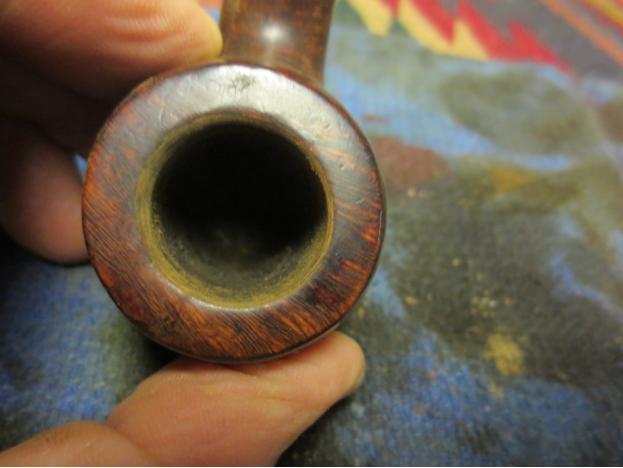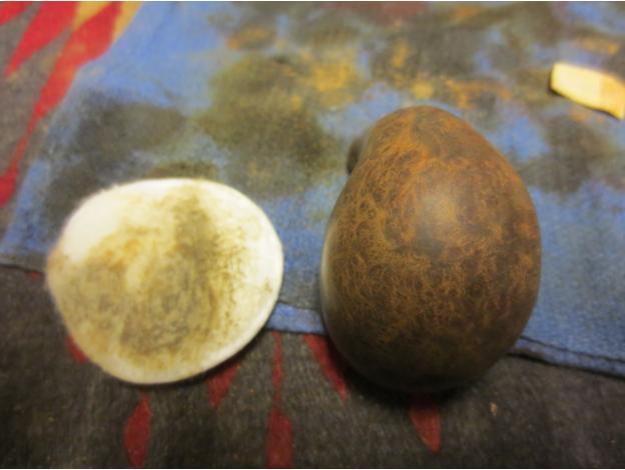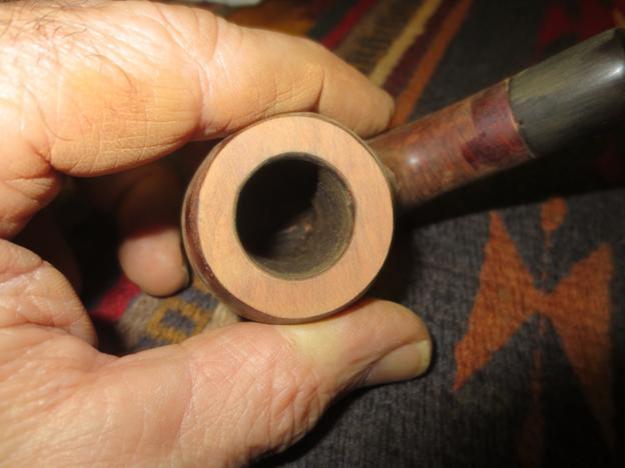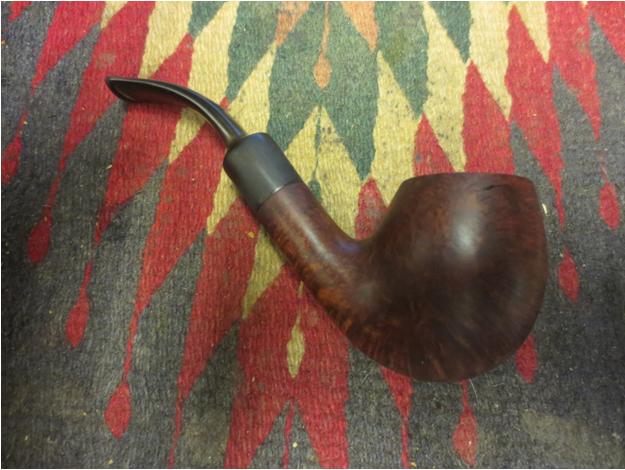Blog by Steve Laug
The next pipe on the work table is the last of the group of six pipes I bought from a fellow in Eastern Canada. It included two Canadian made pipes – a Blatter of Montreal and a Trypis. In the mix was an English made Charatan second stamped Mountbatten and two Peterson’s and an Irish Second. The pipes were well used and all had been smoked. The seller sent me a photo of the pipes so that I could see what he was selling. We discussed some options together and arrived at an agreement and the pipes were on their way to me in Vancouver. The last pipe was a smooth Blatter Montreal Bent Apple with a vulcanite stem that came with brushed tan fabric pipe sock.
The last pipe was a smooth Blatter Montreal Bent Apple with a vulcanite stem that came with brushed tan fabric pipe sock. This is what I saw when I took the pipe out of the sock. The bowl and the rim top are smooth with a two black spots on the lower left side of the heel and shank. The pipe is stamped on the left side of the shank and reads Blatter in script [over] MONTREAL. The finish had some grime ground into the smooth finish of the bowl but still looked to be in good condition. The bowl was thickly caked with some light lava on the top at the back and some darkening on the top and the inner edge of the rim. The taper stem had some light tooth chatter on the top and underside near the button. It had promise but it was dirty. I took some photos of the pipe before I started my cleanup work.
This is what I saw when I took the pipe out of the sock. The bowl and the rim top are smooth with a two black spots on the lower left side of the heel and shank. The pipe is stamped on the left side of the shank and reads Blatter in script [over] MONTREAL. The finish had some grime ground into the smooth finish of the bowl but still looked to be in good condition. The bowl was thickly caked with some light lava on the top at the back and some darkening on the top and the inner edge of the rim. The taper stem had some light tooth chatter on the top and underside near the button. It had promise but it was dirty. I took some photos of the pipe before I started my cleanup work. 
 I took photos of the rim top and bowl to give a clear picture of the thickness of the cake and the overflow of lava on the back rim top and inner edge. I also took photos of the top and underside of the stem to show the chatter and tooth marks.
I took photos of the rim top and bowl to give a clear picture of the thickness of the cake and the overflow of lava on the back rim top and inner edge. I also took photos of the top and underside of the stem to show the chatter and tooth marks.  I took photos of the sides and heel of the bowl to give a picture of what the nice looking grain around the pipe looked like. There is some stunning grain under the grime.
I took photos of the sides and heel of the bowl to give a picture of what the nice looking grain around the pipe looked like. There is some stunning grain under the grime. 
 I took a photo of the stamping on the left side of the shank. It read as noted above and is clear and readable. It also shows the classic Blatter stem logo “dot” – in this case a red dot.
I took a photo of the stamping on the left side of the shank. It read as noted above and is clear and readable. It also shows the classic Blatter stem logo “dot” – in this case a red dot. I removed the stem from the shank and took a photo of the pipe to give a sense of the proportion of this Billiard and the slightly bent stem.
I removed the stem from the shank and took a photo of the pipe to give a sense of the proportion of this Billiard and the slightly bent stem. I turned to Pipephil to confirm what I remembered about Blatter of Montreal. I wanted to read a bit of the history (http://pipephil.eu/logos/en/logo-b5.html). I have included a screen capture of information on the site below. I have also included information from the sidebar below the screen capture.
I turned to Pipephil to confirm what I remembered about Blatter of Montreal. I wanted to read a bit of the history (http://pipephil.eu/logos/en/logo-b5.html). I have included a screen capture of information on the site below. I have also included information from the sidebar below the screen capture. Blatter & Blatter Inc. Pipemakers since 1907. Artisan: Robert Blatter See also: Rettalb
Blatter & Blatter Inc. Pipemakers since 1907. Artisan: Robert Blatter See also: Rettalb
I learned from the above information on the screen capture that the pipe was a 1 red dot: Machine carved pipe. The second photo from the top of the picture is stamped like the one that I am working on today.
I turned to the section on Pipedia about Blatter (https://pipedia.org/wiki/Blatter_%26_Blatter).  I quote from the site below with the aid of Google Translate:
I quote from the site below with the aid of Google Translate:
The Blatter house (first known as “Blatter bros.”) was founded in 1907 in Montreal. Handmade Blatter pipes (“Select”) have been signed by Robert Blatter since 1968 and, more recently, also by Patrick Blatter. A Blatter is characterized by a classic, polished design: little extravagance or sculptural prowess. Pipes first thought for the use that will be made of them: smoking! They are sometimes even more beautiful.
History of the House:
Blatter was founded in Montreal in 1907 by Frédéric-Georges Blatter. Originally from France, Mr. Blatter had learned his craft as a pipe-maker in his country of origin. He had subsequently practiced his art in England, then in South Africa where the excellence of his work had also been highlighted. In 1907, the company had a factory and a store.
Frédéric-Georges is supported by his son, Ernest Blatter, and his half-brother, Henri Blatter. In the years that followed, the company grew rapidly. Soon, the factory employs fifty employees who supply pipes to five stores. But the years of the Great Depression and those of the Second World War were not kind to the company, which had to reduce its activities. At the turn of the 1950s, production and sales activities were brought together in a single establishment.
In the meantime (in the 1930s) Ernest Blatter’s son, Henri-Georges, joined the team and led its destiny until his death in 1967. One of his sons , Pierre, who had been there for a few years, then took up the torch, soon (1968) supported by his brother, Robert, who had since been making Blatter pipes.
In 1997, Patrick, one of Pierre’s sons, joined the duo and learned the rules of the trade from his uncle.
Thus, for 100 years now, five generations of Blatters have succeeded in managing this company, recognized since then by pipe smokers for the excellence of its achievements and the quality of the various services (choice of tobacco, repairs and maintenance, advice) that it offers to its customers.
In 1993, the firm (which clients simply call “the Blatter Brothers”) deserved to be among a select group of a few companies recognized in Quebec for the excellence of their commercial services.
The current production of Blatter pipes is some 300 pieces per year, entirely handmade by Robert Blatter who has acquired, over the years, an excellent reputation among smokers who own one or more of the remarkable objects he makes. For a few years, Patrick has also been making them, under the supervision of Robert.
The firm sources its raw materials from major manufacturers in Saint-Claude (France), with whose managers the Blatter brothers have established, over the years, cordial relations that substantially go beyond the status of simple business relations. Blatter pipes are, to a large extent, sold in the Montreal market (although the firm has a few customers in the United States and Europe), and house regulars often fight over the new pieces.
The demand for these pipes far exceeds the production capacity of the company and on a few occasions in recent years opportunities to relaunch the business on a larger scale have presented themselves. But the Blatter brothers (in good pipe smokers that they are first and foremost!) preferred to give up their big dreams of glory in order to keep intact the quality control they can exert on a small production of pieces. unique.
Pierre and Robert Blatter were inducted into the Confrérie des maîtres-pipiers de Saint-Claude in 1982. (yc)
Here is the information to enable you to connect with the shop.
Blatter & Blatter Inc. Fabricants de pipes depuis
375 President Kennedy
Montreal, Quebec, CANADA
Tel / Fax: 514-845-8028
Website: Blatter & Blatter Inc.
E-mail: mailto:info@blatterpipes.com
I have worked on quite a few Blatter pipes (and enjoyed a fair number in my own collection) through the years and it is always a pleasure as they are well engineered and made.
I started my work on the pipe by reaming the bowl of the pipe with a PipNet Pipe Reamer using the first and second cutting heads to remove all of the cake. I cleaned up the remnants of the cake on the walls with a Savinelli Fitsall Pipe Knife. I finished by sanding the bowl walls smooth with 220 grit sandpaper wrapped around a piece of dowel. 
 I cleaned up the inner edge of the rim with a folded piece of 220 grit sandpaper. I was able to remove almost all of the darkening with the sandpaper.
I cleaned up the inner edge of the rim with a folded piece of 220 grit sandpaper. I was able to remove almost all of the darkening with the sandpaper.  I scrubbed the externals of the pipe with undiluted Murphy’s Oil Soap with a tooth brush. I rinsed it under running warm water to remove the soap and grime. The bowl and rim top cleaned up really well with the lava coat removed. The inner edge of the rim was in good condition.
I scrubbed the externals of the pipe with undiluted Murphy’s Oil Soap with a tooth brush. I rinsed it under running warm water to remove the soap and grime. The bowl and rim top cleaned up really well with the lava coat removed. The inner edge of the rim was in good condition. 
 I cleaned out the inside of the mortise, shank and the airway in the stem with isopropyl alcohol, cotton swabs and pipe cleaners.
I cleaned out the inside of the mortise, shank and the airway in the stem with isopropyl alcohol, cotton swabs and pipe cleaners.  The pipe had a strong aromatic smell just like the other two Petersons I just completed. It smelled like a mix of fruit and vanilla so it needed to be deghosted. I filled the bowl with cotton boles and twisted a plug into the shank end. I used and ear syringe to fill the bowl with alcohol. The alcohol will eventually evaporate from the bowl wicking out the oils and tars in the briar into the cotton. I let it sit over night and in the morning pulled it out and took photos of the cotton at that point.
The pipe had a strong aromatic smell just like the other two Petersons I just completed. It smelled like a mix of fruit and vanilla so it needed to be deghosted. I filled the bowl with cotton boles and twisted a plug into the shank end. I used and ear syringe to fill the bowl with alcohol. The alcohol will eventually evaporate from the bowl wicking out the oils and tars in the briar into the cotton. I let it sit over night and in the morning pulled it out and took photos of the cotton at that point. 
 I polished the smooth briar with micromesh sanding pads – dry sanding with 1500-12000 grit pads and wiped it down with a damp cloth after each sanding pad. By the end of the last set of three the bowl took on a rich shine.
I polished the smooth briar with micromesh sanding pads – dry sanding with 1500-12000 grit pads and wiped it down with a damp cloth after each sanding pad. By the end of the last set of three the bowl took on a rich shine.




 I worked some Before & After Restoration Balm into the surface of the briar with my fingertips to clean, enliven and protect the briar. I let the balm sit for 15 minutes and then buffed with a cotton cloth to raise the shine. The photos show the bowl at this point in the restoration process.
I worked some Before & After Restoration Balm into the surface of the briar with my fingertips to clean, enliven and protect the briar. I let the balm sit for 15 minutes and then buffed with a cotton cloth to raise the shine. The photos show the bowl at this point in the restoration process. 

 I set the bowl aside and turned my attention to the stem. I sanded out the tooth marks and chatter with a folded piece of 220 grit sandpaper. The quality of the vulcanite was very high and did not show oxidation. I started the polishing of the stem with 400 grit wet dry sandpaper.
I set the bowl aside and turned my attention to the stem. I sanded out the tooth marks and chatter with a folded piece of 220 grit sandpaper. The quality of the vulcanite was very high and did not show oxidation. I started the polishing of the stem with 400 grit wet dry sandpaper.  I polished the vulcanite stem with micromesh sanding pads – 1500-12000 grit pads. I wiped the stem down with Obsidian Oil after each sanding pad. I polished the stem with Before and After Stem Polish – both Fine and Extra Fine. I rubbed it down with some more Obsidian Oil.
I polished the vulcanite stem with micromesh sanding pads – 1500-12000 grit pads. I wiped the stem down with Obsidian Oil after each sanding pad. I polished the stem with Before and After Stem Polish – both Fine and Extra Fine. I rubbed it down with some more Obsidian Oil.
 It was great to finish this Blatter of Montreal Bent Apple. I put the pipe back together and buffed it with Blue Diamond on the buffing wheel. I gave the rusticated portion of the bowl multiple coats of Conservator’s Wax and the smooth portions and the stem multiple coats of carnauba wax. I buffed the pipe with a clean buffing pad to raise the shine. I hand buffed the pipe with a microfiber cloth to deepen the shine. It is fun to see what the polished bowl looks like with deep sandblast all around it. Added to that the polished black, vulcanite, fishtail stem was beautiful. This Blatter Bent Apple is great looking and the pipe feels great in my hand. It is light and well balanced. Have a look at it with the photos below. The dimensions are Length: 5 ½ inches, Height: 1 ¾ inches, Outside diameter of the bowl: 1 ¼ inches, Chamber diameter: ¾ of an inch. The weight of the pipe is 45 grams/ 1.59 ounces. It is a beautiful pipe and one that will soon be on the rebornpipes store in the Canadian Pipe Makers Section of the store. If you want to add it to your collection let me know. Thanks for walking through the restoration with me as I worked over this pipe. Thanks to each of you who are reading this blog.
It was great to finish this Blatter of Montreal Bent Apple. I put the pipe back together and buffed it with Blue Diamond on the buffing wheel. I gave the rusticated portion of the bowl multiple coats of Conservator’s Wax and the smooth portions and the stem multiple coats of carnauba wax. I buffed the pipe with a clean buffing pad to raise the shine. I hand buffed the pipe with a microfiber cloth to deepen the shine. It is fun to see what the polished bowl looks like with deep sandblast all around it. Added to that the polished black, vulcanite, fishtail stem was beautiful. This Blatter Bent Apple is great looking and the pipe feels great in my hand. It is light and well balanced. Have a look at it with the photos below. The dimensions are Length: 5 ½ inches, Height: 1 ¾ inches, Outside diameter of the bowl: 1 ¼ inches, Chamber diameter: ¾ of an inch. The weight of the pipe is 45 grams/ 1.59 ounces. It is a beautiful pipe and one that will soon be on the rebornpipes store in the Canadian Pipe Makers Section of the store. If you want to add it to your collection let me know. Thanks for walking through the restoration with me as I worked over this pipe. Thanks to each of you who are reading this blog.



















































































































































